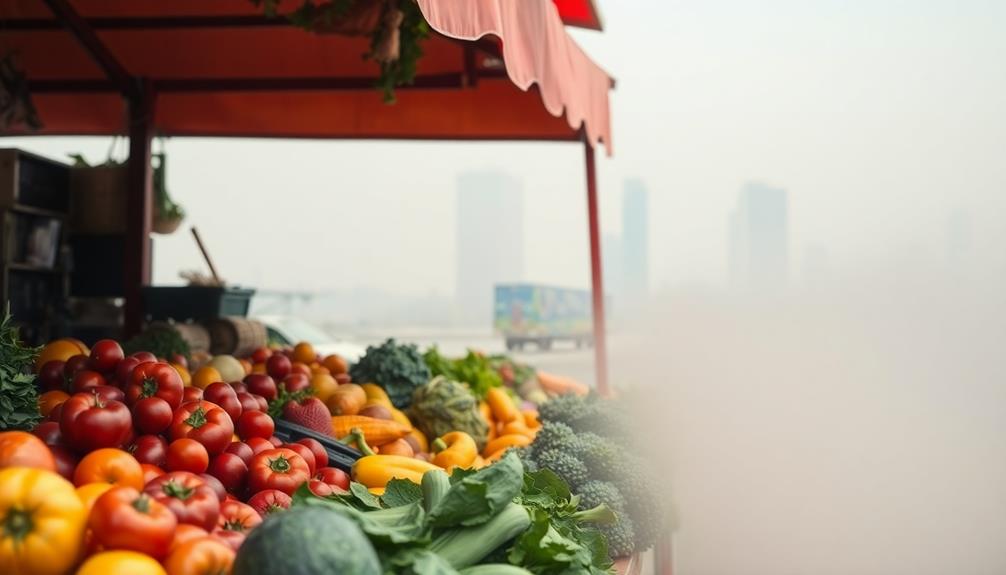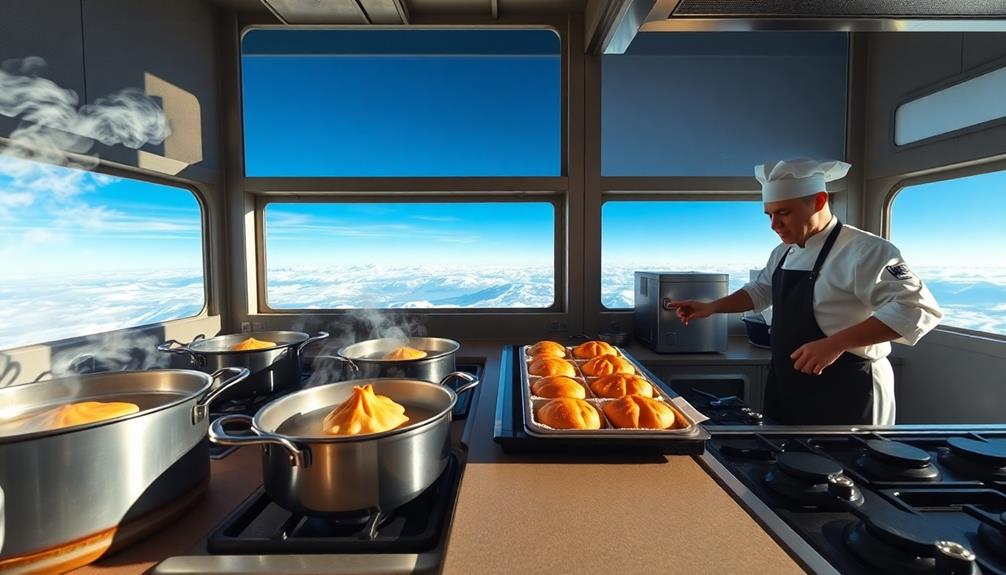To keep your meal preps safe, store cooked foods in airtight containers in the fridge for no more than 3-4 days at or below 40°F. Use freezer temperatures of 0°F or lower for longer storage. Always check for signs of spoilage, like bad odors or discoloration, and reheat foods to at least 165°F. Adjust storage methods for hot or cold climates, and follow proper thawing techniques to prevent bacteria growth. Keep going to discover more tips for safe meal prepping.
Key Takeaways
- Store cooked meal preps in the fridge for no more than 3-4 days at or below 40°F (4°C).
- Keep frozen foods at 0°F (-18°C) or lower to prevent spoilage.
- Use airtight, labeled containers and rotate contents regularly to ensure freshness and safety.
- Thaw frozen meals in the fridge, microwave, or cold water, avoiding room temperature thawing.
- Reheat foods to an internal temperature of 165°F (74°C) and avoid multiple reheating cycles.
Understanding Safe Storage Durations for Meal Preps

To keep your meal preps safe to eat, it’s important to know how long they can be stored without risk. Proper food rotation helps guarantee you use older meals first, reducing the chance of spoilage. When storing leftovers, prioritize portion control by dividing meals into smaller containers. This makes it easier to grab only what you need and minimizes repeated opening of the fridge, which can compromise freshness. Typically, cooked meal preps stay safe for 3 to 4 days in the refrigerator. Beyond that, bacteria can grow, increasing the risk of foodborne illness. Using proper storage materials significantly contributes to maintaining food quality and safety. Choosing appropriate containers that seal tightly helps prevent contamination and spoilage. Incorporating temperature control practices, such as keeping the refrigerator at or below 40°F (4°C), further reduces bacterial growth. Additionally, understanding food safety guidelines can help you make informed decisions about storage durations. By practicing good food rotation and controlling portion sizes, you can extend the freshness of your meal preps and keep them safe for consumption within recommended storage durations.
Optimal Temperatures for Refrigeration and Freezing

Maintaining the right temperatures in your refrigerator and freezer is essential for keeping your meal preps safe and fresh. Proper temperature control prevents bacteria growth and preserves quality. For refrigeration, keep your fridge at or below 40°F (4°C), ensuring a stable environment despite climate changes. If you live in a warmer climate, check your thermometer regularly and avoid overloading, which can hinder airflow. For freezing, set your freezer to 0°F (-18°C) or lower. This temperature slows bacterial activity and keeps food safe for longer periods. Adapt your settings as needed based on seasonal temperature shifts to prevent fluctuations. Consistent temperature control is key to preventing spoilage and maintaining the safety of your meal preps, regardless of climate variations. Additionally, monitoring temperature fluctuations can help you respond promptly to any changes that might compromise food safety. Understanding temperature stability is crucial for effective food storage management, especially as technology advances to improve automation in food safety practices.
Identifying Signs of Spoiled Food
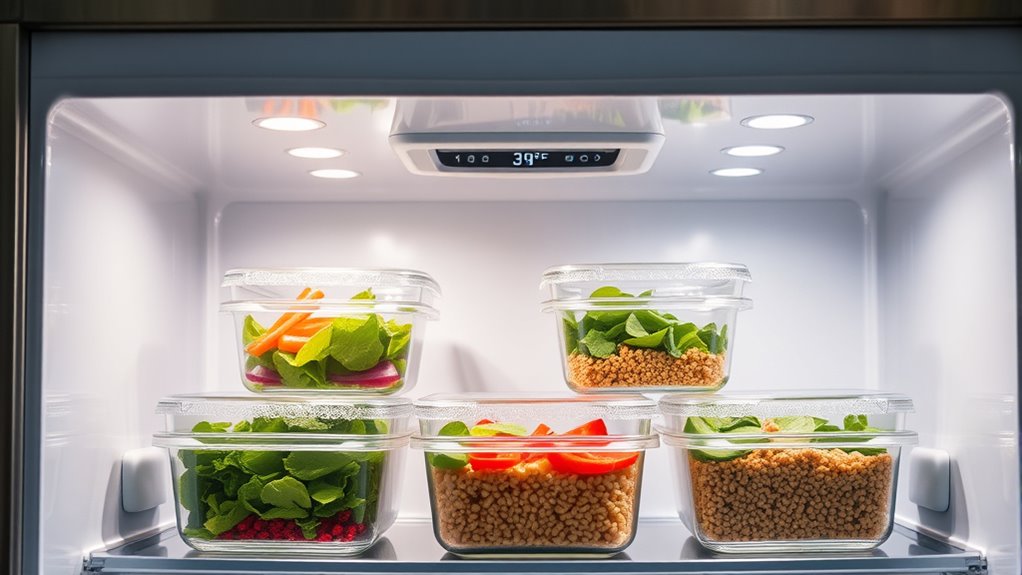
Even when your fridge and freezer are set to the right temperatures, food can still spoil if you’re not attentive to warning signs. Recognizing visual spoilage helps you avoid foodborne illness and waste. Look for discoloration, such as gray or green patches, which indicates bacterial growth. Slimy textures or an unusual, unpleasant odor are clear clues that food is no longer safe to eat. Mold growth on surfaces or packaging is a sign of spoilage, and bubbles or puffiness in sealed containers can signal bacterial activity. Always trust your senses—if anything seems off visually or smells strange, discard the food immediately. Regularly inspecting stored food guarantees you’re aware of spoilage signs and keeps your meals safe. Additionally, understanding proper storage times and temperatures is crucial for maintaining food safety and preventing spoilage, especially considering food safety standards set by health authorities. Being familiar with food preservation techniques can also help extend shelf life and reduce waste. Using appropriate food storage containers can further help maintain freshness and prevent contamination.
Proper Packaging and Container Choices

Using airtight containers helps keep your meals fresh and prevents leaks. Make certain your containers are microwave-safe to avoid harmful chemical exposure when reheating. Clear labels with dates and contents ensure you quickly identify your meals and stay organized. Incorporating proper storage techniques can also help maintain nutrient quality and reduce food waste. Using the right container materials aligned with food safety standards ensures optimal preservation. Additionally, proper packaging can prevent contamination and spoilage, safeguarding your health. Selecting appropriate storage temperatures is essential to inhibit bacterial growth and extend shelf life.
Airtight Sealing Importance
Have you ever opened a container of leftovers only to find they’ve dried out or spoiled faster than expected? Proper packaging and container choices are essential, especially the importance of airtight sealing. When you use containers with a tight seal, you prevent air from entering, which helps preserve freshness and prevents spoilage. Choosing durable containers ensures they won’t crack or leak over time, maintaining airtight sealing even with frequent use. Additionally, good lighting can help you quickly identify spoiled food before consumption, ensuring safety and quality. Implementing proper storage temperatures further supports food safety and extends shelf life, making temperature control an important aspect of meal prep. Proper food storage practices are also crucial for maintaining food quality and safety.
Microwave-Safe Materials Choice
When selecting containers for storing leftovers, it’s important to contemplate not just airtight sealing but also whether they’re microwave-safe. Using microwave-safe materials guarantees your food heats evenly without releasing harmful chemicals. Durable containers are essential—they withstand repeated use and resist cracking or warping. Choose containers made from materials like glass or BPA-free plastics, which are known for their container durability. Consider the following options:
| Material | Durability | Microwave Safety |
|---|---|---|
| Glass | High | Yes |
| BPA-free plastic | Moderate | Yes |
| Polypropylene | Moderate | Yes |
Opt for these materials to keep your leftovers safe, fresh, and easy to reheat. Additionally, selecting containers that are compatible with food safety standards helps ensure your stored food remains safe for consumption over time. Proper food storage practices also extend the freshness and safety of your leftovers.
Clear Labeling Practices
Ever wondered if your leftovers are properly identified and organized? Clear labeling practices make sure your meals stay safe and fresh. Use food labeling to include essential details like contents, date marking, and storage instructions. Proper packaging helps prevent cross-contamination and spoilage. Choose containers that are airtight, microwave-safe, and clearly labeled. When labeling, write legibly and include the date you prepared or stored the meal—this helps track freshness. Additionally, using proper packaging materials can extend the shelf life of your food and maintain quality. Also, incorporate labels that specify reheating instructions if needed. Regularly check labels and discard any food past its safe storage time. Implementing food safety measures in your storage routine can further reduce the risk of foodborne illnesses. Effective labeling reduces confusion and waste, ensuring you consume meals safely. Remember, good labeling practices are key to maintaining meal prep safety and preventing foodborne illnesses. Incorporating mindfulness techniques, such as mindful organization and attention to detail, can further enhance your meal prep safety.
Handling and Storing Raw vs. Cooked Ingredients

Why is it crucial to handle and store raw and cooked ingredients separately? Mixing them increases the risk of cross contamination, which can cause foodborne illnesses. To prevent this, always store raw ingredients below cooked items in the fridge, avoiding drips or contact. Proper hand hygiene is essential; wash your hands thoroughly before handling different ingredients to prevent bacteria transfer. Use separate cutting boards and utensils for raw meats and cooked foods, and clean them thoroughly after each use. Keep raw ingredients in sealed containers to prevent leaks. By following these practices, you minimize cross contamination, ensuring your meals stay safe and healthy. Proper handling and storage are key steps in maintaining food safety during meal prep.
Tips for Reheating Safely
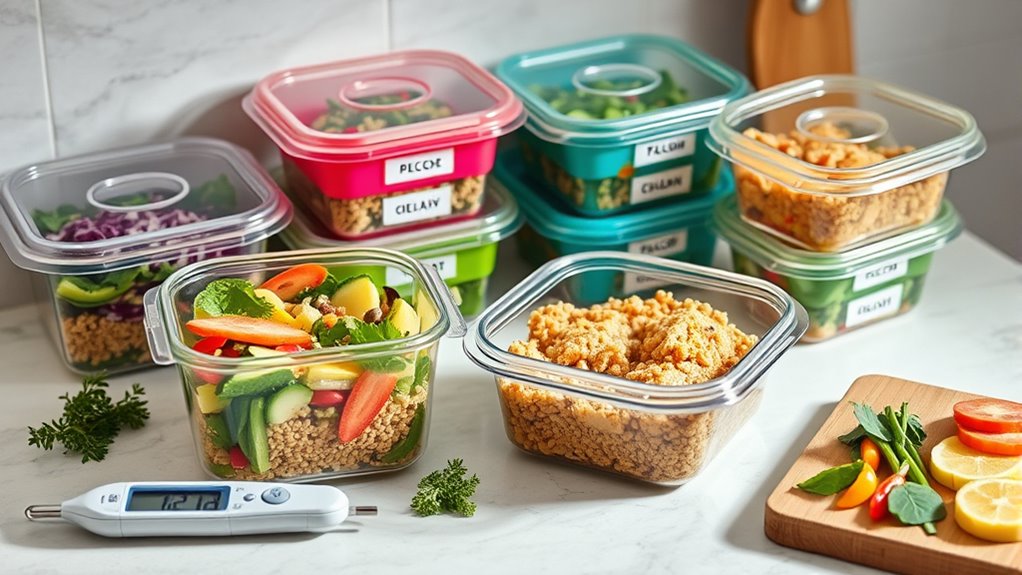
Proper handling and storage set the foundation for safe meal prep, but knowing how to reheat leftovers properly is equally important to prevent foodborne illnesses. Bacteria growth can occur quickly if reheating techniques aren’t followed correctly. To ensure safety, always reheat food to an internal temperature of 165°F (74°C). Use a food thermometer to verify. Stir or rotate food during reheating for even heat distribution. Avoid reheating multiple times, as bacteria can multiply with each cycle. Cover dishes to retain moisture and heat evenly. When reheating in the microwave, let food sit for a minute before checking the temperature to allow heat to distribute properly. These tips help minimize bacteria growth and ensure your leftovers are safe to eat.
Strategies for Meal Prepping in Hot and Cold Climates
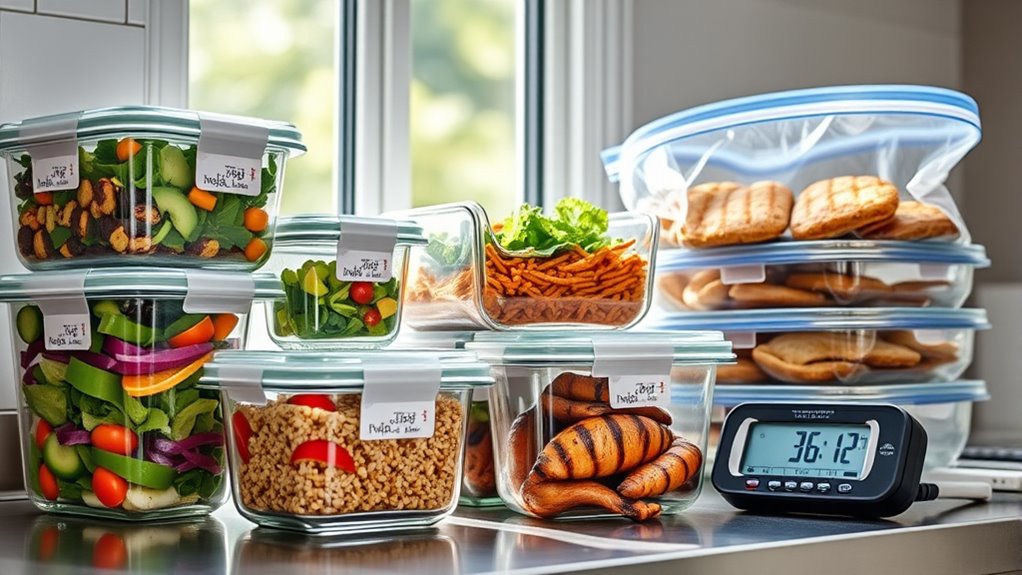
When meal prepping in different climates, you need to adjust storage temperatures to keep food safe. In hot weather, keeping foods cool is essential, so consider using insulated containers or additional ice packs. Cold climates also require proper insulation to prevent foods from freezing or spoiling, ensuring they stay fresh until mealtime.
Adjust Storage Temperatures
Adjusting storage temperatures based on your climate is essential for keeping meal prep safe and fresh. Proper temperature regulation guarantees food remains within safe limits, preventing bacterial growth. In hot environments, keep perishables at or below 40°F (4°C) to avoid spoilage. In colder climates, store items just above freezing, but avoid freezing foods prematurely. Ensure your storage environment maintains consistent temperatures, avoiding fluctuations that can compromise food safety.
- Use a thermometer in your fridge or cooler to monitor temperatures regularly
- Store hot foods in the refrigerator within two hours of cooking
- Keep cold foods chilled on ice packs if refrigeration isn’t available
- Avoid overloading storage spaces to promote air circulation
- Adjust storage locations seasonally to maintain ideal temperature regulation
Use Insulated Containers
Using insulated containers is essential for maintaining the right temperature of your meal preps, especially in extreme climates. These containers help with temperature regulation, keeping hot foods hot and cold foods cold for longer periods. In hot weather, insulated containers prevent your meals from spoiling quickly, reducing bacteria growth. Conversely, in cold climates, they keep foods chilled and fresh, preventing spoilage. Choose high-quality insulated containers with tight-fitting lids to minimize temperature fluctuations. Pre-chill or pre-heat your containers as needed to enhance insulation. Proper use of insulated containers guarantees your meals stay safe to eat and maintain their quality until consumption. Investing in the right containers can make meal prep safer, more convenient, and more effective regardless of climate conditions.
Best Practices for Thawing Frozen Meals

Thawing frozen meals safely is crucial to prevent bacterial growth and guarantee food quality. Proper thawing methods follow safety guidelines to keep your meals safe to eat. The best practices include planning ahead to thaw in the refrigerator, which maintains a consistent temperature and minimizes risk. You can also use the microwave’s defrost setting for quick thawing, but cook immediately afterward. Cold water thawing is effective if sealed in a leak-proof bag, changing the water every 30 minutes. Avoid thawing at room temperature, as it encourages bacteria growth. Always label thawed meals with the date and consume within recommended storage times to ensure freshness and safety.
Thoroughly thaw meals in the refrigerator or microwave, avoiding room temperature to prevent bacteria growth.
- Use the refrigerator for slow, even thawing
- Follow microwave safety guidelines for quick thawing
- Submerge sealed packages in cold water, changing regularly
- Never thaw at room temperature
- Cook immediately after water or microwave thawing
Frequently Asked Questions
How Can I Prevent Cross-Contamination During Meal Prep Storage?
To prevent cross-contamination during meal prep storage, you should focus on food allergen management and proper cleaning techniques. Always store raw meats separately from cooked foods and use sealed containers. Clean all surfaces and utensils thoroughly between uses to avoid allergen transfer. Label storage containers clearly, and never reuse containers that held allergens for other foods. These practices help keep your meals safe and allergen-free.
What Are the Best Labels to Use for Meal Prep Dates?
Did you know that properly labeled meals are 30% less likely to be wasted? When it comes to date labeling, use clear, waterproof labels or masking tape with a permanent marker to note prep dates and expiration dates. This helps you track freshness and reduces food waste. Stick to consistent labeling methods, so you always know exactly when to consume or discard your meals.
Can I Safely Reheat Meals Multiple Times?
Reheating meals multiple times isn’t recommended because it can compromise microwave safety and increase the risk of bacteria growth. Follow reheating guidelines by only reheating your food once, making sure it’s heated to at least 165°F. When reheating, stir your food to ensure even heating and avoid hot spots. Always check that your meal is steaming hot before eating, and store leftovers promptly to maintain safety.
How Does Humidity Affect Storage Times and Food Safety?
Did you know high humidity can double the risk of food spoilage? Humidity impact is significant because moist environments promote bacteria growth. When storage areas are humid, foods spoil faster, reducing safe storage times. To keep your meals safe, store leftovers in airtight containers and use dehumidifiers if possible. Managing humidity levels helps prevent bacteria proliferation and extends your food’s freshness, ensuring you enjoy safe, delicious meals longer.
Are There Specific Containers Recommended for Microwave Reheating?
When reheating food in the microwave, use microwave-safe containers to prevent harmful chemicals from leaching into your food. Look for BPA-free plastics or glass, as these materials are safest for microwave use. Avoid metal or non-microwave-safe plastics, which can cause sparks or melting. Always check the container’s label for microwave safety, and leave a vent or lid slightly open to allow steam to escape, ensuring safe reheating.
Conclusion
By understanding safe storage times, maintaining proper temperatures, and choosing the right packaging, you safeguard your meals and your health. Recognize signs of spoilage, handle raw and cooked ingredients carefully, and reheat thoughtfully. Whether in hot or cold climates, follow best practices for thawing and storing. With these strategies, you guarantee every meal prep is safe, fresh, and delicious—because your health, your peace of mind, and your enjoyment depend on it.





